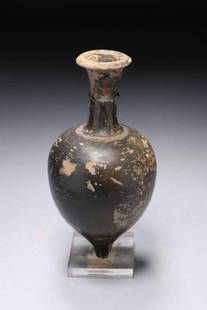
Greek Attic Red-Figure Kylix w/ Nude Ephebe
Similar Sale History
View More Items in Vases & VesselsRelated Vases & Vessels
More Items in Pre-Columbian Vases & Vessels
View MoreRecommended Decorative Objects
View More






Item Details
Description
Ancient Greece, Athens / Attic, ca. 5th to 4th century BCE. A beautiful pottery kylix enveloped in lustrous black pigment and a red-figure tondo of a nude ephebe before an altar. The handsome youth stands in contrapposto with one leg bent and faces right. His right arm bends to rest his hand just above his bulbous posterior as he extends for his left arm, gesturing as though in conversation or presenting something. A band of white fugitive pigment crowns his head, and an annular border frames the scene. The vessel itself is comprised of a shallow bowl flanked by a pair of loop handles, all sitting upon a discoid foot and enveloped in a lustrous black glaze. Size: 6.1" L x 8.8" W x 1.8" H (15.5 cm x 22.4 cm x 4.6 cm)
According to the Walter's Museum of Art, "Kylikes were the most common form of drinking vessel in ancient Greece. The exterior was often elaborately decorated, while the tondo in the center was revealed after the contents of the cup were consumed (the scenes were sometimes amusing as well as artistic) ...At the end of a symposium, the reveler might have used this kylix to participate in a game of kottabos, which involved flinging the dregs of his wine from his cup at a target."
Perhaps the most exciting innovation in Greek vessel painting was the red-figure technique, invented in Athens around 525 BCE and beloved by other artists of Magna Graecia. The red-figure technique allowed for much greater flexibility as opposed to the black-figure technique, for now the artist could use a soft, pliable brush rather than a rigid metal graver to delineate interior details, play with the thickness of the lines, as well as build up or dilute glazes to create chromatic effects. The painter would create figures by outlining them in the natural red of the vase, and then enrich these figural forms with black lines to suggest volume, at times perspectival depth, and movement, bringing those silhouettes and their environs to life.
Virtually no ancient Greek paintings have survived the tests of time. This makes the painted compositions found on ceramic vessels like this example invaluable sources of information about ancient Greek visual art. Refined dishes like this kylix were not merely utilitarian pottery, but rather works of art in their own right, highly prized throughout the classical world.
Provenance: private Orange County, California, USA collection acquired before 2000
All items legal to buy/sell under U.S. Statute covering cultural patrimony Code 2600, CHAPTER 14, and are guaranteed to be as described or your money back.
A Certificate of Authenticity will accompany all winning bids.
We ship worldwide to most countries and handle all shipping in-house for your convenience.
#178912
According to the Walter's Museum of Art, "Kylikes were the most common form of drinking vessel in ancient Greece. The exterior was often elaborately decorated, while the tondo in the center was revealed after the contents of the cup were consumed (the scenes were sometimes amusing as well as artistic) ...At the end of a symposium, the reveler might have used this kylix to participate in a game of kottabos, which involved flinging the dregs of his wine from his cup at a target."
Perhaps the most exciting innovation in Greek vessel painting was the red-figure technique, invented in Athens around 525 BCE and beloved by other artists of Magna Graecia. The red-figure technique allowed for much greater flexibility as opposed to the black-figure technique, for now the artist could use a soft, pliable brush rather than a rigid metal graver to delineate interior details, play with the thickness of the lines, as well as build up or dilute glazes to create chromatic effects. The painter would create figures by outlining them in the natural red of the vase, and then enrich these figural forms with black lines to suggest volume, at times perspectival depth, and movement, bringing those silhouettes and their environs to life.
Virtually no ancient Greek paintings have survived the tests of time. This makes the painted compositions found on ceramic vessels like this example invaluable sources of information about ancient Greek visual art. Refined dishes like this kylix were not merely utilitarian pottery, but rather works of art in their own right, highly prized throughout the classical world.
Provenance: private Orange County, California, USA collection acquired before 2000
All items legal to buy/sell under U.S. Statute covering cultural patrimony Code 2600, CHAPTER 14, and are guaranteed to be as described or your money back.
A Certificate of Authenticity will accompany all winning bids.
We ship worldwide to most countries and handle all shipping in-house for your convenience.
#178912
Condition
Professionally repaired and restored with some minor nicks to surface. Otherwise, excellent presentation with nice shine to glaze. Remains of modern sticky tack on underside of foot, likely from previous display.
Buyer's Premium
- 26.5%
Greek Attic Red-Figure Kylix w/ Nude Ephebe
Estimate $2,400 - $3,600
25 bidders are watching this item.
Shipping & Pickup Options
Item located in Louisville, CO, usSee Policy for Shipping
Local Pickup Available
Payment
Accepts seamless payments through LiveAuctioneers

Related Searches
TOP





































































